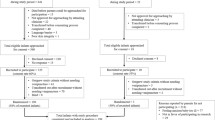Abstract
The study was planned to measure the reduction of the load of bacterial flora on the blood donor’s arm quantitatively using a three step protocol of donor arm cleansing incorporating either 70% isopropyl alcohol (IPA) or 5% w/v povidone iodine (PVI, 0.5% w/v available iodine) or 4% chlorhexidine gluconate (CHG) with or without the addition of 5% dimethyl sufloxide (DMSO). Single blind randomized study after obtaining ethical clearance, using the Miles and Misra technique for quantification and matrix assisted laser desorption ionization-mass spectrometry for identification of colony morphotypes on blood donor’s skin. The mean pre-cleansing colony forming units (CFUs) was 89,318 and mean post-cleansing CFUs was 132, with a mean reduction of 99.85% with a mean log reduction of 3.24 (95% CI 2.01–4.47) at a P value of <0.0001. The post-cleansing CFUs was reduced to zero in all 34 samples in the protocol using CHG with DMSO, in 23 of 31 samples in the protocol using PVI with DMSO and 19 of 29 samples in the protocol using IPA with DMSO. The difference in means of the reduction of CFUs in protocols using CHG with DMSO compared with protocols using PVI or IPA with DMSO and PVI or IPA without DMSO was statistically significant with P value of 0.006, 0.0009, 0.015 and 0.05 respectively. The enhanced cutaneous antisepsis effect of CHG when complimented with DMSO in presence of IPA using the three step protocol of donor arm cleansing could stimulate more research and utilization of this as an additional safety towards the prevention of the problem of bacterial contamination of blood and blood components.
Similar content being viewed by others
References
EcEntegtart MG (1956) Dangerous contaminants in stored blood. Lancet 271:909–911
Pittman M (1953) A study of bacteria implicated in transfusion reactions and bacteria isolated from blood products. J Lab Clin Med 42:273–288
Novak M (1939) Preservation of stored blood with sulfanilamide. JAMA 113:2227–2229
Strumia MM, McGraw JJ (1941) Frozen and dried plasma for civil and military use. JAMA 116:2378–2382
Gibson T, Norris W (1958) Skin fragments removed by injection needles. Lancet 2:983–985
Wagner SJ, Friedman LI, Dodd RY (1994) Transfusion-associated bacterial sepsis. Clin Microbiol Rev 7:290–302
Morrow JF, Braine HG, Kickler TS et al (1991) Septic reactions to platelet transfusions. A persistent problem. JAMA 266:555–558
Asher D, Atterbury CLJ, Chapman C, Cohen H, Jones H, Love EM et al; on behalf of the Serious Hazards of Transfusion (SHOT) Steering Group: The 2000/2001 annual SHOT report. http:///www.shotuk.org/wp-content/uploads/2010/03/SHOTReport-00–01.pdf
Puckett A, Davison G, Entwistle CC, Barbara JAJ (1992) Post transfusion septicaemia 1980–89: importance of donor arm cleansing. J Clin Pathol 45:155–157
McDonald CP, Lowe P, Roy A, Robbins S, Hartley S, Harrison JF et al (2001) Evaluation of donor arm disinfection techniques. Vox Sang 80:135–141
Perez P, Bruneau C, Chassaigne M, Salmi LR, Noel L, Allouch P et al (2002) Multivariate analysis of determinants of bacterial contamination of whole-blood donations. Vox Sang 82:55–60
Follea G, Saint-Laurent P, Bigey F, Gayet S, Bientz M, Cazenave JP (1997) Quantitative bacteriological evaluation of a method for skin disinfection in blood donors. Transfus Clin Biol 4:523–531
Goldman M, Roy G, Frechette N, Decary F, Massicotte L, Delage G (1997) Evaluation of donor skin disinfection methods. Transfusion 37:309–312
Schreiber GB, Arduino MJ, Holt SC, Carson LA, Banerjee SN, Jarvis WR (2001) Transfusion-transmitted bacterial infection in the United States, 1998 through 2000. Transfusion 41:1493–1499
Stainsby D, Cohen H, Jones H, Knowles S, Milkins C, Charpman C et al (2003) Serious hazards of transfusion (SHOT). SHOT annual report, pp 1–88
Perez P, Salmi LR, Follea G, Schmit JL, de Barbeyrac B, Sudre P et al (2001) Determinants of transfusion associated bacterial contamination: results of the French BACTHEM case-control study. Transfusion 41:862
Annual SHOT Report 2014 Supplementary Information Chapter 17: Transfusion-transmitted infections (TTI). http://www.shotuk.org/wp-content/uploads/Chapter-17-TTI-Supplementary-Information-2014.pdf
Miles AA, Misra SS, Irwin JO (1938) The estimation of the bactericidal power of the blood. J Hyg (Lond) 38:732–749
McDonald C, McGuane S, Thomas J, Hartley S, Robbins S, Roy A et al (2010) A novel rapid and effective donor arm disinfection method. Transfusion 50:53–58
Wong PY, Colville VL, White V, Walker HM, Morris RA, Microbial Contamination and Infection Control Subcommittee, Australian Red Cross Blood Service (2004) Validation and assessment of a blood-donor arm disinfectant containing chlorhexidine and alcohol. Transfusion 44:1238–1242
Darouiche RO, Wall MJ Jr, Itani KM, Otterson MF, Webb AL, Carrick MM et al (2010) Chlorhexidine–alcohol versus povidone-iodine for surgical-site antisepsis. N Engl J Med 362:18–26
Adler MT, Brigger KR, Bishop KD, Mastrobattista JM (2012) Comparison of bactericidal properties of alcohol-based chlorhexidine versus povidone-iodine prior toamniocentesis. Am J Perinatol 29:455–458
Tschudin-Sutter S, Frei R, Egli-Gany D, Eckstein F, Valderrabano V, Dangel M et al (2012) No risk of surgical site infections from residual bacteria after disinfection with povidone-iodine-alcoholin 1014 cases: a prospective observational study. Ann Surg 255:565–569
Sistla SC, Prabhu G, Sistla S, Sadasivan J (2010) Minimizing wound contamination in a ‘clean’ surgery: comparison of chlorhexidine-ethanol and povidone-iodine. Chemotherapy 56:261–2677
Girard R, Comby C, Jacques D (2012) Alcoholic povidone-iodine or chlorhexidine-based antiseptic for the prevention of central venous catheter-related infections: in-use comparison. J Infect Public Health 5:35–42
Tarrand JJ, LaSala PR, Han XY, Rolston KV, Kontoyiannis DP (2012) Dimethyl sulfoxide enhances effectiveness of skin antiseptics and reduces contamination rates of blood cultures. J Clin Microbiol 50:1552–1557
Author information
Authors and Affiliations
Corresponding author
Ethics declarations
Conflict of interest
The authors disclose no conflicts of interest and no financial funding from any commercial organisation. The study was funded by PGIMER, Chandigarh, India.
Rights and permissions
About this article
Cite this article
Sachdev, S., Sethuraman, N., Gautam, V. et al. Evaluation of the Role of Novel Aprotic Dimethyl Sulfoxide in Cutaneous Antisepsis Protocols Prior to Blood Donor Phlebotomy with Isopropyl Alcohol, Povidone Iodine or Chlorhexidine. Indian J Hematol Blood Transfus 34, 132–137 (2018). https://doi.org/10.1007/s12288-017-0816-x
Received:
Accepted:
Published:
Issue Date:
DOI: https://doi.org/10.1007/s12288-017-0816-x




